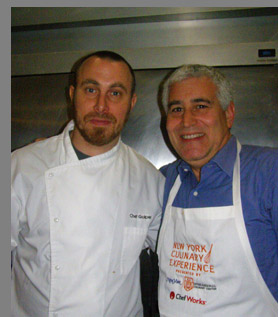Chef Zachary Golper and Edward F. Nesta
"Let’s Make Some Bread"
Since I started making bread at home several years ago, whenever I have the opportunity to take a bread class from a professional chef, I immediately sign up. Learning from industry professionals has allowed me to learn the tricks of the trade and the "secrets" to create well-crafted, artisanal breads. Zachary Golper honed his craft working at top bakeries throughout the United States, opened his own bakery, Bien Cuit in Brooklyn, New York, in 2011 with his wife, Kate Wheatcroft, and has received two James Beard Best Chef nominations. When not busy making bread, he found time to publish a cookbook, Bien Cuit: The Art of Bread. With this list of credentials, I knew I was in excellent hands withChef Zachary Golper.
Over the course of the 3-hour and 15-minute class, Zachary put the class through our paces learning to make three delicious types of bread. The Madawaska Bread dates back to the Acadian settlers from the mid-west of France who came over to Canada and proceeded to farm hardy vegetables like potatoes along with grains such as buckwheat, which would become signature ingredients in their breads. The Madawaska bread we made was dark, flat, dense and extremely tasty, and best of all, it holds for days, and does not go stale quickly.
The class also made the Pugliese bread, Italian rustic (peasant) bread originating in the Puglia area (the southeastern part of Italy). This bread was very different from the Madawaska bread as the Pugliese was much lighter in color, the bread was airy and open, and the taste was memorable [good crumb]. The dough is a wet (slack) dough, which was a bit difficult to work with but the results were worth the effort.
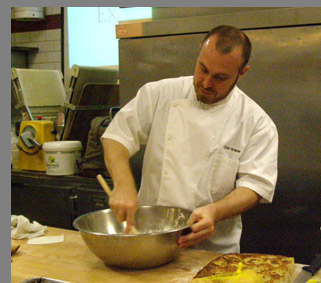
Chef Golper demonstrating mixing technique in large bowl
The last recipe we worked on was the Potato Focaccia. One of the great tricks I learned while making the Potato Focaccia started with the ingredients and a 13" metal bowl. You start by pouring in all of the dry ingredients and thoroughly mixing them together. You then form a well in the middle of the dry ingredients and pour your water in the well. Slowly turn the bowl folding in the dry ingredients from the side (not all at once, go slow and turn the bowl). Then turn the bowl a bit faster and continue to fold in the dry ingredients until all of the dry ingredients have been absorbed in the water. You will end up with a nice ball of sticky, not tacky, dough.
The following recipe calls for garlic oil and roasted garlic, which if bottled as cologne would be on my shelf. Making your own garlic oil and roasted garlic is easy, just place raw, peeled garlic in a roasting pan and cover (just barely) with olive oil and place in the oven at 380˚F (193˚C) and roast until the cloves just begin to turn golden brown. There will be some golden crusts of garlic and oil floating on the top, and once it has cooled down you may be the lucky first person to pick off the floating golden slivers of sweet euphoria. The oil may be stored in a bottle in a cupboard and the roasted garlic pieces may be stored in the refrigerator for weeks, if they last that long in your house.
ChefZachary Golper – NYCE 2016 Class Menu
Madawaska Bread
Pugliese Bread
Potato Focaccia
Suggested wine pairing:
Excelsior Casillero del Diablo Carmenere
Chef Zachary Golper graciously shares his delectable recipe for Potato Focaccia.
Potato Focaccia
Time Schedule:
Preferment must rest 4 hours at room temp.
Dough requires 2 folds, 1-hour rest on sheet pan, de-gassed and spread across pan, then 1-2 hours ambient proofing, then covered with roasted garlic and blanched potato before baking.
Potato Focaccia Ingredients
|
250
|
Grams
|
Bread Flour
|
|
250
|
Grams
|
Duram Flour
|
|
10
|
Grams
|
Yeast
|
|
10
|
Grams
|
Salt
|
|
40
|
Grams
|
Garlic Oil
|
|
250
|
Grams
|
Pate Fermentée*
|
|
400
|
Grams
|
Water
|
Method for the Dough: Mix together all ingredients for the preferment 4-6 hours or so before you mix the dough, or just use some old (non sourdough) dough left over from previous bread from your refrigerator.
*If you use the pâte fermentée method (old dough), it cannot be more than 36 hours old.
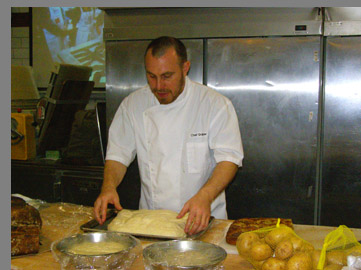
Chef Golper stretching dough
Mix wet and dry ingredients together without potato (as shown in photo). Rest dough 30 minutes fold. Repeat once.
Place on the oiled sheet pan after second fold and proof at room temperature for 30 minutes. De-gas and stretch dough.
Proof 1-2 hours depending on how quickly it is moving. ("Proofing doneness" test to be part of the demo).
*Pâte Fermentée (Old Dough) Ingredients
|
100
|
Grams
|
Water
|
|
150
|
Grams
|
Duram Flour
|
|
1
|
Gram
|
Yeast
|
|
10
|
Gram
|
Salt
|
There are numerous methods for creating pâte fermentée (old dough), which in a Chefy would be dough made up to 36 hours before that is sitting in the refrigerator. In a Chefy, pâte fermentée is used as a base for many of your favorite breads as it add layers of flavor to the finished product.
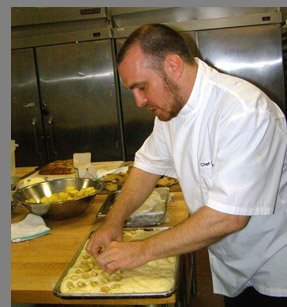
Chef Golper creating Potato Focaccia
Method for Pâte Fermentée by Hand: Mix all of the dry ingredients and then holding back 2 tablespoons of water add the remaining water and mix until the dough forms a ball, if it is too dry then add the water you held out, but not too sticky. Turn out the dough ball onto a lightly floured surface and knead for about 4 to 6 minutes until soft and pliable, tacky but not sticky. You will now store the dough overnight (up to 36 hours) in a refrigerator. First make sure the dough is lightly oiled by rolling the dough in oil in the bowl or container you will be using for storage.
Remove the required amount of pâte fermentée from the refrigerator and let it stand at room temperature for a couple of hours before mixing with the rest of the recipe.
Method for the Potatoes: Slice potatoes one-quarter inch thick. Blanch in boiling water for about 5 minutes. Then place in ice bath. Store in the refrigerator until needed.
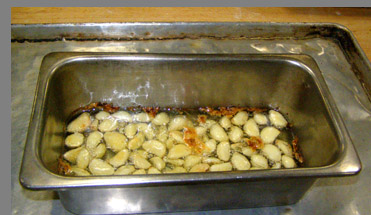
Roasted Garlic
Method for the Garlic Oil: Place raw, peeled garlic in roasting pan and pour in enough safflower or olive oil to cover the garlic cloves just barely. Place in the oven at 380° F (193° C) and roast until the garlic cloves just begin to turn golden brown. Remove from the oven and allow to cool completely. Store in the refrigerator.
Finishing the Focaccia: Place roasted garlic and potatoes on the dough. Sprinkle with salt and bake at 425° F (218° C) until potatoes and dough are fully baked.
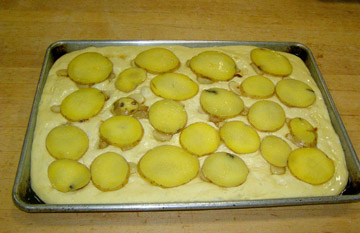
Ready to Bake
 Want more information on the next NYCE? For more information about the New York Culinary Experience, contact Stephanie Fray at nyce@nymag.com or +1-646-314-4413.
Want more information on the next NYCE? For more information about the New York Culinary Experience, contact Stephanie Fray at nyce@nymag.com or +1-646-314-4413.
For information on taking classes throughout the year with the excellent chef instructors at The International Culinary Center at their New York, California, or Italian Campuses, please visit the website: www.InternationalCulinaryCenter.com
Location and Information
The International Culinary Center
462 Broadway
New York, New York 10013
United States
Toll-Free Telephone: +1-888-324-2433
Email: info@internationalculinarycenter.com
Website: www.internationalculinarycenter.com
Follow The International Culinary Center on Facebook at: www.facebook.com/InternationalCulinaryCenter
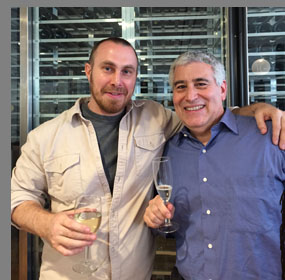
Cheers!!
See you at the New York Culinary Experience
Follow Luxury Experience on Facebook at www.facebook.com/LuxuryExperience to see more photos and watch video clips.
Follow Luxury Experience on Twitter at www.twitter.com/LuxuryPair
© August 2016. Luxury Experience. www.LuxuryExperience.com. All rights reserved.

